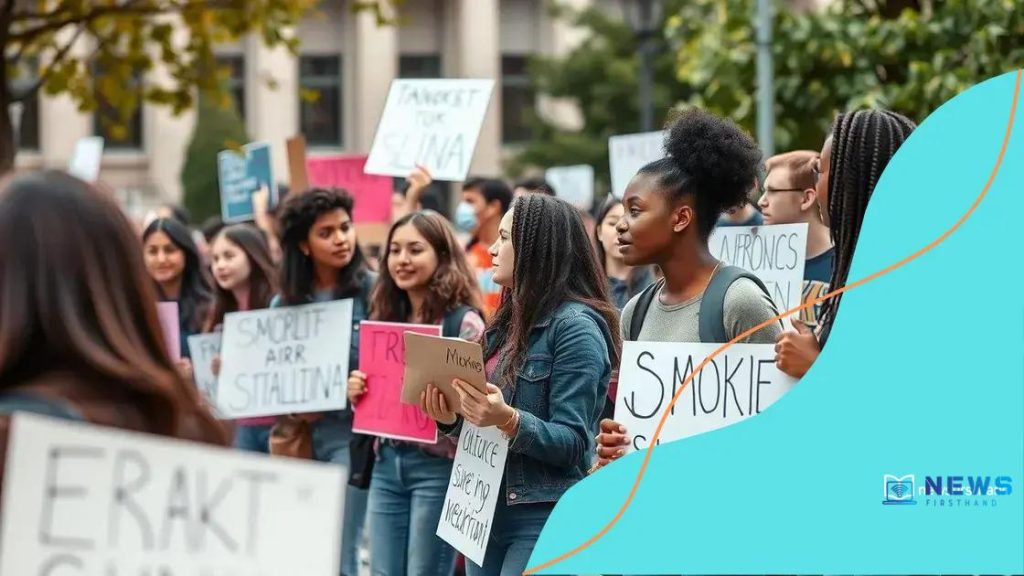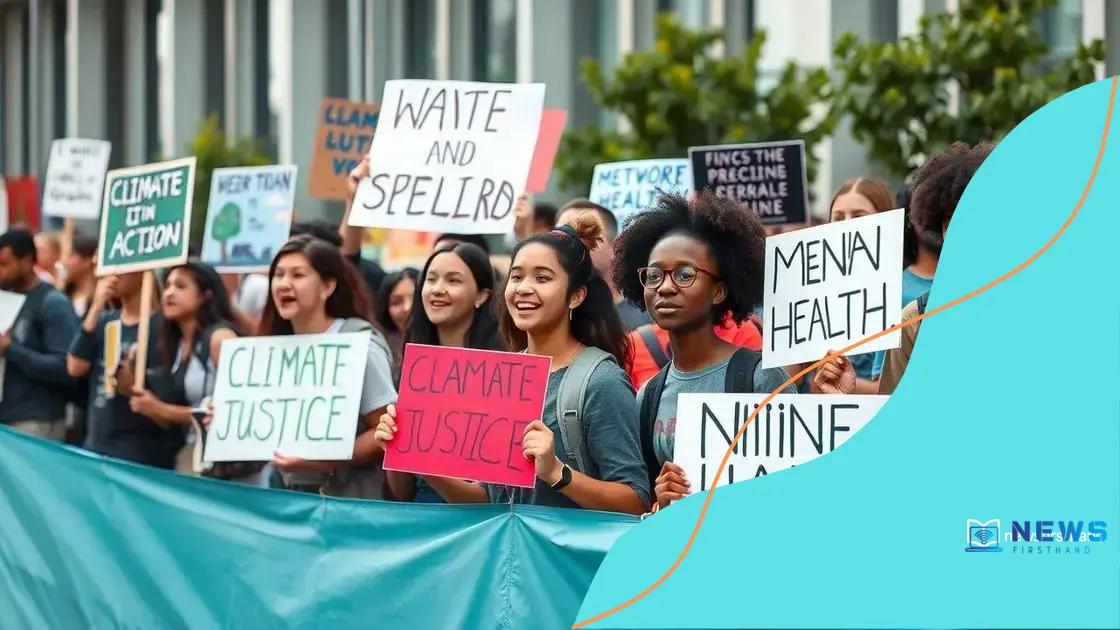Rising influence of student activism on campuses

The rising influence of student activism is reshaping social issues on campuses, empowering students to advocate for change through digital platforms, collaboration, and resilience against challenges.
Rising influence of student activism is reshaping universities worldwide, offering students a platform to voice their concerns and propose changes. Have you noticed how this surge is transforming campus life? Let’s dive into what’s happening.
The power of student voices
The power of student voices has never been more critical. Students today are using their platforms to advocate for change, ensuring their concerns are heard.
Impact of Student Voices
When students raise their voices, they bring attention to important issues like mental health, climate change, and social justice. These movements often inspire others to join in, creating a ripple effect. It’s remarkable to see how students unite over shared beliefs.
Examples of Student Activism
From marches to social media campaigns, student activism manifests in many ways. Here are a few notable examples:
- The March for Our Lives advocating for gun control
- The Climate Strikes led by young activists worldwide
- Local campaigns focusing on inclusivity and diversity on campuses
Such actions demonstrate how student voices can influence policies and shift societal norms. When students collectively voice their concerns, they can change the dialogue at a national level.
Furthermore, many young individuals are leveraging technology to amplify their messages. Social media platforms become powerful tools for activism, allowing for real-time updates and organizing efforts. This digital aspect also helps to connect students globally, fostering a sense of community.
Global youth movements thrive on shared experiences, showcasing the strength of collective action. In this way, every student’s voice adds value to the greater cause, highlighting the unique perspectives they bring.
In exploring the power of student voices, we see just how influential this demographic can be. Their energy and passion are catalysts for change, encouraging engagement and advocacy across various topics.
Historical impact of student activism
The historical impact of student activism has shaped societies in profound ways. Throughout history, students have emerged as powerful agents of change, challenging norms and advocating for their beliefs.
Key Movements
Several significant student-led movements have made headlines and left lasting legacies. These movements not only brought attention to pressing issues but also mobilized communities. Consider the following:
- The Civil Rights Movement in the 1960s, where students played a pivotal role
- The Vietnam War protests that united students across campuses in the 1970s
- The anti-apartheid movement that saw global student support, including major universities
These events illustrate how student voices contribute to shaping political landscapes. Often, young activists spark dialogues that ripple beyond their immediate environment.
As we look at these historical moments, it’s clear that the passion and drive of students often lead to systemic changes. They not only challenge existing policies but also encourage broader societal discussions.
Continuing the Legacy
The legacy of past student activism continues today. Modern movements, inspired by the successes of their predecessors, reflect the ongoing struggle for justice and equity. Social media has further amplified these voices, enabling students to connect globally and share their stories.
Whether addressing climate change or advocating for mental health resources, students are at the forefront, reminding us of their critical role in society. Their ability to organize and mobilize can drive substantial change.
In examining the historical context of student activism, we can appreciate the groundwork laid by those before. Their efforts pave the way for future generations, ensuring that the spirit of activism lives on.
Modern movements led by students

Modern movements led by students are reshaping our world today. These young activists are addressing various issues that affect their lives and futures. Their energy and passion often inspire change and bring attention to urgent matters.
Current Issues Addressed by Student Activism
Students today tackle a range of critical issues. Here are a few important topics they focus on:
- Climate change and environmental sustainability
- Racial justice and equality
- Mental health awareness
- Gun control and safety
These areas reflect not only the concerns of students but also the pressing challenges society faces. They often organize protests, rallies, and campaigns to raise awareness and demand action.
Through social media, students amplify their voices, connecting with peers and spreading their messages widely. Platforms like Instagram and Twitter serve as vital tools for organizing and mobilizing support. Many have garnered thousands of followers, using their influence to inspire others to join the cause.
Impact and Achievements
The impact of modern student movements can be significant. For instance, the Fridays for Future movement, initiated by Greta Thunberg, has encouraged students around the globe to participate in climate strikes. This activism has pushed governments to consider more robust environmental policies.
Another notable movement is the March for Our Lives, which arose in response to gun violence in schools. Students have effectively advocated for stricter gun control laws, making their voices heard among policymakers.
In addition, mental health advocacy has gained momentum, thanks to students sharing their experiences and pushing for better resources on campuses. This surge in awareness encourages open discussions and removes the stigma around mental health issues.
As these movements grow, they prove that student activism is not just a trend but a powerful force for change. The determination of young people to create a better future showcases their role as leaders in society.
Challenges faced by student activists
Student activists encounter numerous challenges as they strive to make their voices heard and effect change. These obstacles can sometimes hinder their efforts but also strengthen their resolve.
Facing Opposition
One major challenge is facing opposition from various groups. Whether it’s from peers, administration, or even parents, student activists often deal with criticism. Some may not understand the issues at heart, which can lead to misunderstandings.
- Miscommunication of the students’ goals
- Resistance from school officials
- Negative reactions from the community
Despite these setbacks, many student activists find ways to engage in dialogue, aiming to bridge gaps and promote understanding.
Limited Resources
Another hurdle is having limited resources. Many student-led initiatives lack funding or support structures that established organizations might enjoy. This can restrict their ability to organize events, conduct outreach, or print materials.
Students often have to rely on creativity and grassroots efforts to get their message across. They might use social media to promote campaigns or partner with local groups for support. This resourcefulness showcases their determination to succeed against the odds.
Burnout and Mental Health
It’s also important to mention that activism can lead to burnout. Students may feel overwhelmed by the demands of their campaigns and academic responsibilities. Striking a balance is vital for their well-being.
Many activists advocate for mental health resources to support themselves and their peers. This acknowledgment is crucial in ensuring sustainability in their efforts, allowing them to continue advocating for the causes they care about.
In understanding the challenges faced by student activists, we gain insight into their resilience and commitment. They continue to push forward, proving that even when faced with obstacles, their passion for change remains strong.
The future of campus activism
The future of campus activism looks promising as students continue to take a stand on critical issues. As technology evolves, so does the way students organize and advocate for change.
Embracing Digital Platforms
Social media will continue to play a vital role in shaping activism. Platforms like Instagram, Twitter, and TikTok are essential for spreading awareness and mobilizing support. Students can share their messages widely and connect with a global audience.
- Real-time updates on events and initiatives
- Interactive campaigns that engage followers
- Building communities around shared causes
This ability to reach many people quickly enhances the impact of student movements. It encourages participation and amplifies diverse voices advocating for change.
Collaboration and Partnerships
Another significant aspect of the future is collaboration. Students are increasingly partnering with local organizations and national groups. These partnerships provide resources and support that amplifies their efforts.
Working together, they can tackle complex issues like racial equality, climate action, and mental health. These connections not only strengthen movements but also create a broader network of activists united for causes that matter.
As campus activism evolves, it emphasizes the importance of intersectionality. Students recognize that various social issues are often connected. By considering multiple perspectives, activists can create more inclusive movements that represent diverse communities.
Education and Training
Educational institutions are also beginning to support activism through programs and workshops. Many campuses now offer courses and resources focused on social justice and civic engagement. This education empowers students with tools to become effective advocates.
As the landscape of activism shifts, students are gaining skills in organizing, public speaking, and policy advocacy. These experiences provide students with a solid foundation for future leadership roles.
The future of campus activism is bright as students harness their creativity and passion to affect change. By leveraging technology, building partnerships, and investing in education, they are poised to tackle the pressing challenges of our time.
FAQ – Frequently Asked Questions about Campus Activism
What role does social media play in modern campus activism?
Social media serves as a powerful tool for organizing events, spreading awareness, and connecting students globally, enhancing the reach of their messages.
What challenges do student activists commonly face?
Student activists often encounter opposition, limited resources, and the risk of burnout due to their commitments and the demands of activism.
How can students collaborate effectively in activism?
Students can form partnerships with local organizations and national groups to create a stronger support network, enabling them to tackle complex issues more effectively.
What future trends are expected in campus activism?
The future of campus activism may see increased digital engagement, a focus on sustainability, and more educational resources to empower student leaders.





